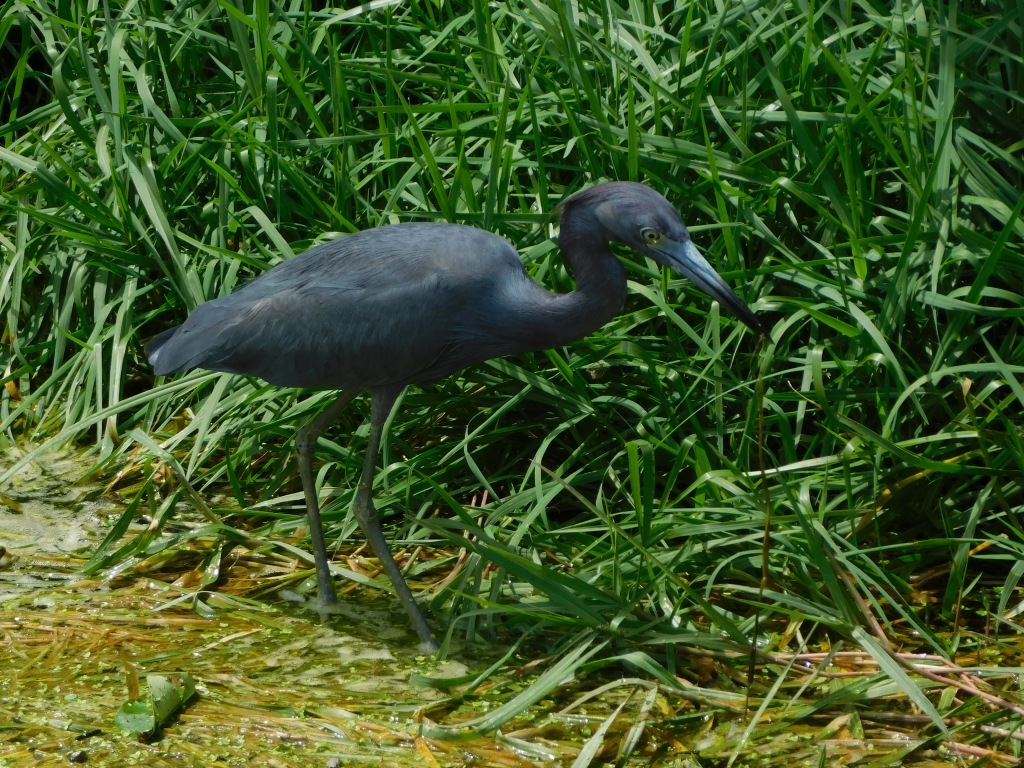
Here’s a birdwatcher etiquette pro tip that you can take or leave: when you are traveling with a non-birdwatcher, don’t make them go birdwatching or otherwise control the trip agenda to include more birdwatching. It just isn’t worth it. To wit, on my recent five-day trip to coastal Florida I saw over 30 species of birds without dragging my spouse (and our non-birdwatching host) anywhere at all.
We weren’t even staying in a particularly promising place bird-wise. It was one of those closely- packed communities with a name ending in “Beach” that dot the Atlantic shoreline of Florida. There is hardly any green space because the real estate is so valuable, all the waterways are in channels, and the beaches are crowded with people from fairly early in the morning till at least sunset.
Given all that, the number of boat-tailed grackles is impressive. In this landscape, these birds are more common than pigeons or starlings. In late March they are also in breeding mode, which means the males give voice to a song much more melodious than that of the common grackle we have up north. This species has an iridescence more greenish-blue than the greenish-purple of its northern counterpart and they are a good 3-4 inches longer.
The second most obvious bird was the Eurasian collared dove, which where I was also outnumbered the pigeons. In 1974, 50 birds were released from captivity in Nassau in the Bahamas (during a burglary!) and the species has now spread across the continent. I encountered it in Portland, Ore. last summer. In Florida it sits in trees more often than a pigeon and does not assemble in groups. Its repeated “coo coo cup” call is a constant background sound in suburban-ish urban settings.
I saw neither common native dove species—mourning and ground—even during a trip to a local arboretum. The most striking sighting I saw there was a blue-headed vireo at a feeder. This species winters in Florida, but it had molted into its breeding plumage in preparation for migration. I was struck by the saturation of its colors; it may have been a member of the Appalachian population, which is darker and has a thicker bill than our northern birds.
We were only three blocks from the beach and during the day I was struck by the lack of shorebirds; it was just too crowded. One morning, however, we walked the shore at around 8 a.m. and saw three species of gulls—herring, ring-billed, and laughing—with the last already having molted into its black-capped breeding plumage. Out on the pier we found two ruddy turnstones foraging for scrapes left by fishermen. They were still in winter garb. I saw terns out over the ocean, but could not identify them. They were one of the smaller species, probably the common tern.
A visit to a genuine wildlife refuge (for about 45 minutes) yielded the expected bumper crop of diversity and numbers. As soon as we were even near it, white and glossy ibises began appearing along drainage ditches in suburban developments. The refuge is 100-acres of reclaimed farmland that has been re-flooded and diked to retain water. It is criss-crossed with wooden boardwalks. The wildlife is accustomed to human visitors and all but ignored our presence.
The anhinga looks like an odd cross between a heron and a cormorant but is in the darter family with its closest relatives found in Africa and India. They are black, flecked with white and chestnut, slightly larger than a cormorant and with a longer heron-like neck and bill. Like cormorants they swim and hunt underwater and must dry off their wings in the sun. They were nesting in March; their young still had down on their bodies but already had real feathers on their wings and tails.
All the herons were sporting their breeding plumes and bright skin and bill coloration. This was particularly striking in a little blue heron, which was entirely blue in March: the bill, the skin around the eyes, and the eye itself. From just feet away, we watched one methodically hunt for small fish.
I think the only “first” I had on this trip was the tri-colored heron that walked right next to the boardwalk, giving me a good look at its white head plumes. A great blue heron flew over and snowy egrets were visible in the distance along the berms that keep the standing water in place. Also dotting the berms, sunning themselves, were black-bellied whistling ducks and blue-winged teals. Along the edge of the water, common gallinules (now called moorhens, as they are deemed conspecific with the European species) stalked among the cattails, coming in close contact with American coots and pie-billed grebes floating on the water itself. Red-winged blackbirds sang from the shrubs that grew in the drier areas. A red-bellied woodpecker built its nest not 20 feet from the boardwalk in a grove of bald cypresses.
As you can see, in less than an hour I was fairly deluged with birds and no one even got their feet wet or shoes dirty. Our host has a new puppy that requires frequent walks through the neighborhood. Those forays were opportunities to listen to the abundant mockingbirds and cardinals singing in the landscape plantings. Blue jays were being blue jays, and all the crows were fish crows. In the sky overhead, platoons of brown pelicans followed the canals and turkey vultures rocked on the thermals, looking for roadkill along the multi-laned, heavily trafficked roads. I was even nostalgic about the house sparrows sorting through the litter on the sidewalks, because I live so far out in the country that I never see this species anymore.
In conclusion, my unsolicited advice is to bring your binoculars and guidebook (and Merlin) wherever you travel, but don’t press your luck. You don’t have to.
Bill Chaisson has been a birdwatcher for over 50 years. He lives and works in Wilmot.